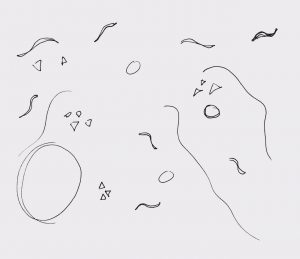/* Submitted by: Michal Luria
Section A: 9:00AM - 10:20AM
mluria@andrew.cmu.edu
Assignment-10-Project
*/
var x = []; //circle X
var y = []; //circle Y
var circSize = []; //size
var circHue = []; //hue
var myParticles = []; //particles
var nParticles = 700;
function setup() {
createCanvas(600,400);
//build an initial array of particles
for (var i = 0; i < nParticles; i++) {
var rx = random(width);
var ry = random(height);
myParticles[i] = makeParticle(rx, ry, 0, 0);
}
//set color to HSB
colorMode(HSB, 100);
frameRate(20);
}
function draw() {
background(0);
fill(255);
noStroke();
push();
//draw particles according to gravity and repulsion forces
//the first part of the code implements the particle code we learned in class
var gravityForcex = 0;
var gravityForcey = 0.05;
var mutualRepulsionAmount = 2.5;
for (var i = 0; i < myParticles.length; i++) {
var ithParticle = myParticles[i];
var px = ithParticle.px;
var py = ithParticle.py;
if (mouseIsPressed) {
ithParticle.addForce(gravityForcex, gravityForcey);
}
for (var j = 0; j < i; j++) {
var jthParticle = myParticles[j];
var qx = jthParticle.px;
var qy = jthParticle.py;
var dx = px - qx;
var dy = py - qy;
var dh = sqrt(dx * dx + dy * dy);
if (dh > 1.0) {
var componentInX = dx / dh;
var componentInY = dy / dh;
var proportionToDistanceSquared = 1.0 / (dh * dh);
var repulsionForcex = mutualRepulsionAmount *
componentInX * proportionToDistanceSquared;
var repulsionForcey = mutualRepulsionAmount *
componentInY * proportionToDistanceSquared;
// add in forces
ithParticle.addForce( repulsionForcex, repulsionForcey);
jthParticle.addForce(-repulsionForcex, -repulsionForcey);
}
}
}
for (var i = 0; i < myParticles.length; i++) {
myParticles[i].bPeriodicBoundaries = false;
myParticles[i].bElasticBoundaries = true;
myParticles[i].update(); // update all locations
}
for (var i = 0; i < myParticles.length; i++) {
myParticles[i].draw(); // draw all particles
}
//----=====end of particle code=====-----//
pop();
//set the likelihood of a circle showing up
var newCircleLikelihood = 0.3;
if (random (0,1) < newCircleLikelihood){
//if new circle is created, push a random location, size and hue
x.push(random(0, width));
y.push(random(0, height));
circSize.push(random(0,2));
circHue.push(random(0,100));
}
//for the circle array length
for (var i = 0; i < x.length; i++) {
var ex = x[i]; //set new x
var ey = y[i]; //set new y
var eCirc = circSize[i]; //set new circle size
var eHue = circHue[i]; //set new hue
fill(eHue, 100, 100);
//every 5 circles draw a moving triangle instead
if (i % 5 == 0){
triangle(ex, ey, ex+random(-20,20), ey, ex+(random(-20,20)), ey-random(-20,20));
//if not triangle, draw circle
} else {
ellipse(ex,ey, eCirc, eCirc); //draw the new circle
}
circSize[i] += random(0,3); //make the circle grow in side
//code to move the circle slightly out of the center
if (x[i] > width/2) { //if on the left side - move left
x[i]+=3 ;
} else { //if on the right side - move right
x[i]-=3 ;
}
if (y[i] > height/2) { //if the circle is on the bottom half
y[i]++ ; //move down
} else { //if on the top half
y[i]-- ; //move up
}
if (circSize[i] > height) { //if the circle is too big
x[i] += 1500; //move it to the side
y[i] += 1500;
}
}
}
// Implementation of partical code with variation
//Mutual repulsion, with optional gravity
// Update the position based on force and velocity
function particleUpdate() {
if (this.bFixed == false) {
this.vx *= this.damping;
this.vy *= this.damping;
this.limitVelocities();
this.handleBoundaries();
this.px += this.vx;
this.py += this.vy;
}
}
// Prevent particle velocity from exceeding maxSpeed
function particleLimitVelocities() {
if (this.bLimitVelocities) {
var speed = sqrt(this.vx * this.vx + this.vy * this.vy);
var maxSpeed = 10;
if (speed > maxSpeed) {
this.vx *= maxSpeed / speed;
this.vy *= maxSpeed / speed;
}
}
}
// do boundary processing if enabled
function particleHandleBoundaries() {
if (this.bPeriodicBoundaries) {
if (this.px > width) this.px -= width;
if (this.px < 0) this.px += width;
if (this.py > height) this.py -= height;
if (this.py < 0) this.py += height;
} else if (this.bHardBoundaries) {
if (this.px >= width) {
this.vx = -abs(this.vx);
}
if (this.px <= 0) {
this.vx = abs(this.vx);
}
if (this.py >= height) {
this.vy = -abs(this.vy);
}
if (this.py <= 0) {
this.vy = abs(this.vy);
}
}
}
// draw the particle as a white circle
function particleDraw() {
fill(255);
noStroke();
ellipse(this.px, this.py, 2, 2);
}
// add a force to the particle using F = mA
function particleAddForce(fx, fy) {
var ax = fx / this.mass;
var ay = fy / this.mass;
this.vx += ax;
this.vy += ay;
}
// make a new particle
function makeParticle(x, y, dx, dy) {
var p = {px: x, py: y, vx: dx, vy: dy,
mass: 1.0, damping: 0.9,
bFixed: false,
bLimitVelocities: false,
bPeriodicBoundaries: false,
bHardBoundaries: false,
addForce: particleAddForce,
update: particleUpdate,
limitVelocities: particleLimitVelocities,
handleBoundaries: particleHandleBoundaries,
draw: particleDraw
}
return p;
}
For the landscape project this week, I wanted to create a project that would give the sense of outer space, with shapes flying your way. In order to do this, I used different shapes in different sizes and colors, and tried to code their movement to seem to move in your direction. In order to make it more interesting, I also added shape shifting triangles.
For the background of the project, I used the particle code we learned in class, because I liked the way it shifts slowly, similar to how we would see movement of something that is very far away.
Attached is a sketch of my initial idea on paper:
![[OLD – FALL 2016] 15-104 • COMPUTING for CREATIVE PRACTICE](wp-content/uploads/2020/08/stop-banner.png)